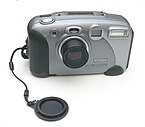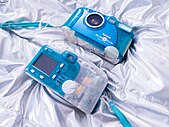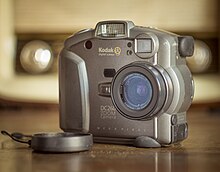
The Kodak DC series was Kodak's pioneering consumer-grade line of digital cameras; as distinct from their much more expensive professional Kodak DCS series. Cameras in the DC series were manufactured and sold during the mid-to-late 1990s and early 2000s. Some were branded as "Digital Science". Most of these early digital cameras supported RS-232 serial port connections because USB hardware was not widely available before 1998. Some models in the DC series ran on the short lived DigitaOS, a camera operating system that allowed third party software to be installed.
The DC series was superseded by the Kodak EasyShare camera line.
Kodak DC20
The Kodak DC20 was an early digital camera first released by Kodak in 3 June 1996, in Australia at price of AU$560. It had a manufacturer's suggested retail price of US$299 when most other digital cameras at the time cost well over $1000, and was the first product sold by Kodak through its website. The DC20 only had the most basic features of a digital camera, with only three buttons: power, erase, and shutter release. It had no liquid crystal display (LCD) for reviewing pictures. It came with only 1 megabyte of internal flash memory, which could only store 8 or 16 images, depending on image quality, and did not support external flash memory. It had no built-in photo flash. Its CCD sensor had a maximum resolution of 493×373 pixels. It had a fixed focal length f/4 lens, equivalent to 47 mm for 35 mm single lens reflex film cameras.
With physical dimensions of 31×102×61 mm (1.2×4.0×2.4 in), the Kodak DC20 was the first ultracompact digital camera. Its sleek compact size would remain unrivaled until the release of the Canon Digital Ixus and Casio Exilim.
There were several add-on lenses released for the Kodak DC20. These included a macro adapter, a telephoto converter, and a wide-angle converter from Tiffen. These were clip-on lenses since the original lens had no thread. There was also an add-on photo flash unit made by Kodak.
Kodak DC25
The Kodak DC25 was released about the same time as the Kodak DC20. They used the same 493×373 pixel CCD sensor and 47 mm-equivalent lens. They also shared a similar form factor and shape. However the DC25 was considerably larger than the DC20 because it carried an LC display for picture review. Moreover, the Kodak DC25 was among the first cameras to have a PCMCIA slot to support CompactFlash cards (branded "Picture Card") for external storage. It did not support the JPEG image file format, storing images in Kodak's proprietary K25 file format instead, as the JPEG image standard was very new and still under development at the time the camera was being designed.
Kodak DC40
Released in 1995, the DC40 shared its lineage with the Apple QuickTake 100, both of which were manufactured by Chinon. It came with fixed focal length lens of 42 mm-equivalent and a 768x512 pixel CCD sensor. It came with 4 megabyte of internal flash memory storage and did not have any capabilities for using external memory. It also did not have an LCD for picture display. The cost was $1,000.
Kodak DC50
 Kodak DC 50 – front view
Kodak DC 50 – front view Kodak DC 50 – back view
Kodak DC 50 – back view
This early digital camera is a clone of the Chinon ES-3000. The design was also licensed to other manufacturers and sold as, Dycam 10-C, Promaster Digital One, and Dakota DCC-9500; but with improved software, a higher resolution sensor, and a dark gray case. The Kodak DC50 featured a 3:1 zoom lens (37 mm to 111 mm-equivalent), built-in photo flash and a PCMCIA slot for Type I and II ATA cards. It came with a simple monochrome LCD to report basic camera statistics, but did not come with a graphical LCD for picture review. The Kodak DC50 had a 768x512 pixel color CCD sensor, just like the Kodak DC40 (usually displayed at 756x504). It only stored images in Kodak's proprietary KDC file format with 3 user-selectable quality levels.
Kodak DC120
Released in 1997, the Kodak DC120 had a similar size and form factor as the DC40 and the DC50. Like the DC50, it also had a 3:1 zoom lens. However, it boasted a larger 1280×960 pixel CCD sensor and built-in photo flash. It had 2 megabytes of internal picture storage and supported CompactFlash external memory storage. It also had a color LCD for picture review. It continued to use Kodak's KDC file format. The camera had an optical viewfinder with dual target rings in the center to account for parallax over the zoom range.
The DC120 required 6 to 6.8 volts DC power, supplied by four AA-size 1.7 V lithium primary cells. Although nickel-metal hydride (Ni-MH) 1.25 V or nickel-cadmium (Ni-Cd) 1.2 V cells could be used, due to their lower capacity and discharge characteristics they needed to be replaced frequently — every 20 to 30 pictures, or so. Ordinary alkaline or carbon-zinc primary cells could be used for daylight photography and during storage to keep the camera's internal clock running and preserve settings, but they had excessive internal resistance and insufficient current capacity to power the camera when the photo flash was in use. An optional external AC adapter could also be used, supplying 7-8 VDC via a coaxial power plug, for transferring pictures to a computer or for fixed use indoors.
DigitaOS models
DigitaOS was intended to automate certain camera features through user-created scripts. In addition, users could use software written for Digita to extend camera functionality, including Digita FX, a program which enabled in-camera image editing.
Kodak DC220 and DC260
 Kodak DC220
Kodak DC220 Kodak DC260
Kodak DC260
The DC220 and DC260 were released in 1998 and were closely related internally; while the DC220 had a 2× zoom lens (29–58 mm equivalent with a close-up mode) and maximum resolution of 1152×864 (XGA+), the DC260 was equipped with a 3× zoom lens (38–115 mm equivalent) and a higher maximum resolution of 1536×1024.
Kodak DC265
The DC265 was an upgraded DC260, equipped with a faster processor while retaining the same maximum resolution and zoom lens.
Kodak DC290

The DC290 also used the same lens as the DC260, with an increased maximum resolution of 2240×1500 (interpolated from 1792×1200). It was released in fall 1999.
Kodak DC240
 Kodak DC 240
Kodak DC 240 Kodak DC 240i (blueberry)
Kodak DC 240i (blueberry)
The Kodak DC240 and DC240i are digital cameras that were manufactured and sold by Kodak during the late 1990s and early 2000s The DC240 was announced on February 26, 1999, and had a resolution of 1.2 megapixels, a 3x optical zoom, and a CompactFlash slot. The DC240i was a limited edition camera that was released in 1999 and was identical to the DC240 but included a skeleton USB and video cable. It was rebadged and re-issued in the style of the iMac G3 and available in the identical five colors as the G3 at this time: blueberry (blue), strawberry (pinkish), lime (green), grape (lilac) and tangerine (orange).
Full model list


- DC10 — 0.? megapixel, 47 mm equivalent fixed lens
- DC20 — 0.2 megapixel, 47 mm equivalent fixed lens
- DC25 — 0.2 megapixel, 47 mm equivalent fixed lens, CompactFlash slot
- DC40 — 0.38 megapixel, 42 mm equivalent fixed lens f/2.8
- DC50 — 0.38 megapixel, 37–111 mm equivalent lens, PCMCIA slot
- DC120 — 1 megapixel, 38–114 mm equivalent lens, CompactFlash slot
- DC200 — 1 megapixel, 39 mm equivalent fixed lens, CompactFlash slot
- DC200 Plus — 1 megapixel, 39 mm equivalent fixed lens, CompactFlash slot
- DC210 — 1 megapixel, 2x optical zoom lens, CompactFlash slot
- DC210 Plus — 1 megapixel, 2x optical zoom lens, CompactFlash slot
- DC215 — 1 megapixel, 2x zoom lens, CompactFlash slot
- DC220 — 1 megapixel, 29 mm to 58 mm equivalent lens, 2x zoom lens + 2x digital zoom, CompactFlash slot
- DC240 — 1.2 megapixels, 3x optical zoom + 2x digital zoom, CompactFlash slot, announced 26 Feb. 1999
- DC260 — 1.6 megapixels, 3x optical zoom + 2x digital zoom, CompactFlash slot
- DC265 — 1.6 megapixels, 3x optical zoom + 2x digital zoom, CompactFlash slot
- DC280 — 2 megapixels, 2x optical zoom + 3x digital zoom, CompactFlash slot
- DC290 — 2.1 megapixels, 3x optical zoom + 2x digital zoom, CompactFlash slot
- DC3200 — 1.3 megapixels, fixed lens, 2mb internal memory, CompactFlash slot
- DC3400 — 2 megapixels, 2x optical zoom + 3x digital zoom, CompactFlash slot
- DC3800 — 2.1 megapixels, 2x digital zoom (but only usable on lesser quality setting), CompactFlash slot
- DC4800 — 3.1 megapixels, 3x optical zoom + 1x digital zoom, CompactFlash slot
- DC5000 — 2 megapixels, 2x optical zoom + 3x digital zoom, CompactFlash slot, weatherproof rugged camera
References
- "DIGITA OS". mesh.brown.edu. Retrieved 2020-05-13.
- Jahnke, Art (August 1999). "Still in the Picture". CIO. Retrieved 12 August 2024.
- Grotta, Daniel; Grotta, Sally Wiener (January 7, 1997). "Hardware: Digital Cameras". PC Magazine. pp. 145–177. Retrieved 12 August 2024.
- "Kodak Digital Science DC20 Camera". Kodak Digital Science. Archived from the original on December 2, 2000.
- O'Malley, Chris (March 1997). "Get the Digital Picture". Popular Science. pp. 64–68. Retrieved 12 August 2024.
- Grotta, Daniel; Grotta, Sally Wiener (January 21, 1997). "A Digital Camera for the Point-and-Shoot Crowd". PC Magazine. Retrieved 12 August 2024.
- Greenfield, Lauren (November–December 1997). "American Photo's Guide to the Future, Part II: The Technology". American Photo. Retrieved 12 August 2024.
- Dennis van Hall. "History". Archived from the original on 28 January 2021. Retrieved 17 March 2021.
- Gustavson, Todd (2009). Camera A History of Photography from Daguerreotype to Digital. Sterling Signature. ISBN 978-1-4027-5656-6.
- Dennis van Hall. "Kodak DC50 Zoom". Archived from the original on 12 August 2020. Retrieved 19 Mar 2021.
- ^ Eastman Kodak. "Kodak Digital Science(TM) DC50 zoom camera User's Guide" (PDF). Eastman Kodak. Archived from the original (PDF) on 19 March 2021. Retrieved 19 March 2021.
- "Scripting: The Power to Take Digital Imaging to the Next Level". Kodak. Archived from the original on March 3, 2000.
- Brown, Bruce (April 20, 1999). "First Looks: Rapid-Fire Capture". PC Magazine. Retrieved 12 August 2024.
- Brown, Bruce (October 6, 1998). "First Looks: An OS to Smile For". PC Mag. Retrieved 12 August 2024.
- "DC265 Zoom Digital Camera". Kodak. Archived from the original on August 18, 2000.
- Kay, Russell (April 17, 2000). "Apps Provide Lure For New Digicams". ComputerWorld. Retrieved 12 August 2024.
- "Kodak DC290 Zoom Digital Camera [brochure]". Kodak. Retrieved 12 August 2024.
- Review at digitalkameramuseum.de
- Kodak DC40 user manual.
- Eastman Kodak. "DC200 Camera with Picture Easy Software" (PDF). Eastman Kodak. Archived from the original (PDF) on 13 June 2001. Retrieved 7 December 2020.
- Eastman Kodak. "DC200 Plus Digital Camera" (PDF). Eastman Kodak. Internet Archive. Archived from the original (PDF) on 11 July 2003. Retrieved 7 December 2020.
- Eastman Kodak. "KODAK DIGITAL SCIENCE DC200/DC210 Zoom Cameras Specifications". Eastman Kodak. Internet Archive. Archived from the original on 21 March 2007. Retrieved 7 December 2020.
- Eastman Kodak. "KODAK DC210 Plus Zoom Digital Camera" (PDF). Eastman Kodak. Internet Archive. Archived from the original (PDF) on 23 August 2000. Retrieved 7 December 2020.
- Eastman Kodak. "DC220 Zoom Camera with Picture Easy Software 3.0" (PDF). Eastman Kodak. Internet Archive. Archived from the original (PDF) on 2 February 1999. Retrieved 5 December 2020.
- Eastman Kodak. "Kodak DC240 digital camera specifications". Archived from the original on 21 June 2006. Retrieved 7 December 2020.
- Eastman Kodak. "DC260 Zoom Camera with Picture Easy Software 3.0" (PDF). Eastman Kodak. Archived from the original (PDF) on 2 February 1999. Retrieved 7 December 2020.
- Eastman Kodak. "DC265 Zoom Digital Camera" (PDF). Eastman Kodak. Archived from the original (PDF) on 23 August 2000. Retrieved 7 December 2020.
- Eastman Kodak. "DC280 Zoom Digital Camera" (PDF). Eastman Kodak. Archived from the original (PDF) on 31 August 2000. Retrieved 7 December 2020.
- Eastman Kodak. "DC290 Zoom Digital Camera" (PDF). Eastman Kodak. Archived from the original (PDF) on 22 August 2000. Retrieved 7 December 2020.
- Eastman Kodak. "KODAK DC3200 Digital Camera User's Guide Camera Specifications". Eastman Kodak. Internet Archive. Archived from the original on 20 December 2002.
- Eastman Kodak. "KODAK DC3400 Zoom Digital Camera User's Guide Camera Specifications". Eastman Kodak. Archived from the original on 25 January 2001. Retrieved 9 December 2020.
- Eastman Kodak. "KODAK DC3800 Zoom Digital Camera User's Guide Camera Specifications". Eastman Kodak. Internet Archive. Archived from the original on 27 January 2001. Retrieved 9 December 2020.
- Eastman Kodak. "KODAK DC4800 Zoom Digital Camera User's Guide DC4800 Zoom Camera Specifications". Eastman Kodak. Internet Archive. Archived from the original on 12 December 2000. Retrieved 9 December 2020.
- Eastman Kodak. "KODAK DC5000 Zoom Digital Camera User's Guide Camera Specifications". Eastman Kodak. Internet Archive. Archived from the original on 3 March 2001. Retrieved 9 December 2020.
External links
![]() Media related to Kodak DC-Series at Wikimedia Commons
Media related to Kodak DC-Series at Wikimedia Commons
| Eastman Kodak | |||||||||||||||||||
|---|---|---|---|---|---|---|---|---|---|---|---|---|---|---|---|---|---|---|---|
| Subsidiaries | |||||||||||||||||||
| Cameras |
| ||||||||||||||||||
| Camera film |
| ||||||||||||||||||
| Other products | |||||||||||||||||||
| Media | |||||||||||||||||||
| Technical standards | |||||||||||||||||||
| People | |||||||||||||||||||
| Places | |||||||||||||||||||
| Court cases | |||||||||||||||||||
| Processes | |||||||||||||||||||
| Related | |||||||||||||||||||